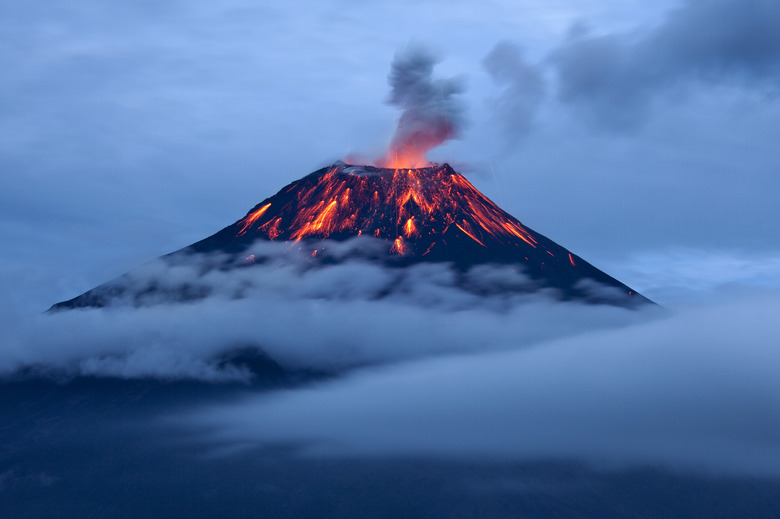What Is "Catastrophism" In Biology?
Biology, the study of life, began as a study of the forms and functions of existing life, mostly plants and animals. Georges Cuvier, an 18th century French scientist, realized through his studies of animal bones and fossils that some forms of life had become extinct. In the 16th century, an Anglican archbishop from Northern Ireland, James Ussher, used Biblical dates to calculate that the Earth could only be about 6,000 years old. Therefore, Cuvier concluded that the extinctions must have been caused by a series of catastrophic events.
Catastrophism Definition
Catastrophism Definition
To define catastrophism requires understanding the origins of the term. Early scientists like Cuvier, who were working within the boundaries of Ussher's calculations of the Earth's age, needed a logical explanation for the sudden disappearance or extinction of species. Cuvier suggested a series of catastrophic events, including the Biblical flood. That early introduction of the term "catastrophism" led to a modification of James Ussher's catastrophism that stated that geologic and biologic changes result from events that would not be seen in the modern world. In addition, those events might or might not have resulted from natural causes. In that vein, Merriam-Webster's catastrophism definition states: "a geological doctrine that changes in the earth's crust have in the past been brought about suddenly by physical forces operating in ways that cannot be observed today."
Uniformitarianism and Gradualism
Uniformitarianism and Gradualism
After James Hutton's 1785 publication of "Theory of the Earth," increasing numbers of scientists came to understand that Earth processes usually are slow, gradual processes. The theory of uniformitarianism requires long periods of time and is summarized with the phrase "the present is the key to the past." In other words, geologic changes are gradual and occurred in the past just like they happen now. Studying modern geologic processes teaches geologists about past processes. In the mid-1800s the Scottish geologist Charles Lyell expanded the idea of uniformitarianism. Lyell's "gradualism" extends the geologic principle to natural chemical and biological events, stating that changes occur gradually over long periods of time.
Catastrophism Examples
Catastrophism Examples
Although catastrophism was largely set aside with the development of uniformitarianism and gradualism, many scientists have come to understand that catastrophic events influencing biology do occur. For example, the catastrophic meteor strike at the end of the Mesozoic, combined with the gradual separation of Pangea, led to the extinction of the dinosaurs, most marine reptiles and many other life forms. Another example of a catastrophic geologic event affecting biology is the 2011 Japanese earthquake that drastically reduced the local population of mud snails and that spread local Japanese flora and fauna across the Pacific Ocean with the tsunami debris. Also, the eruption of large volcanoes like Tambora impact local ecosystems while influencing weather patterns world-wide.
Punctuated Gradualism
Punctuated Gradualism
Punctuated gradualism developed as many scientists began to realize that catastrophic events occur within the slow and gradual changes of the Earth. Past, present and future catastrophic geologic events impact biologic populations. Habitat destruction, short- or long-term food chain disruption and direct impact of catastrophic events like earthquakes and volcanoes continue to influence biology.
References
- Skeptical Inquirer: Creationism, Catastrophism, and Velikovsky
- University of California Museum of Paleontology: Georges Cuvier (1769-1832)
- Pennsylvania State University: Florissant Fossil Beds
- University of Oregon: Catastrophism
- Palomar College: Pre-Darwinian Theories
- University of Illinois at Urbana-Champaign: Georges Cuvier (1769-1832)
- University of Vermont: Mass Extinctions vs. Uniformitarianism in Biological Evolution
- U.S. Geological Survey: Historical Perspective
- The National Academies Press: How Do Earth Systems Interact With Eruptions?
- Scientific Reports: Ecological and Genetic Impact of the 2011 Tohoku Earthquake Tsunami on Intertidal Mud Snails
- Merriam-Webster Dictionary: Catastrophism
Cite This Article
MLA
Blaettler, Karen G. "What Is "Catastrophism" In Biology?" sciencing.com, https://www.sciencing.com/catastrophism-biology-21515/. 24 September 2018.
APA
Blaettler, Karen G. (2018, September 24). What Is "Catastrophism" In Biology?. sciencing.com. Retrieved from https://www.sciencing.com/catastrophism-biology-21515/
Chicago
Blaettler, Karen G. What Is "Catastrophism" In Biology? last modified August 30, 2022. https://www.sciencing.com/catastrophism-biology-21515/
